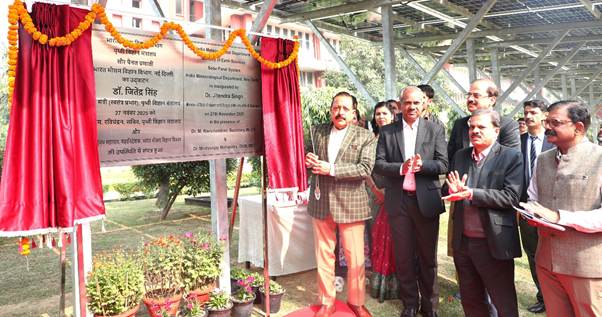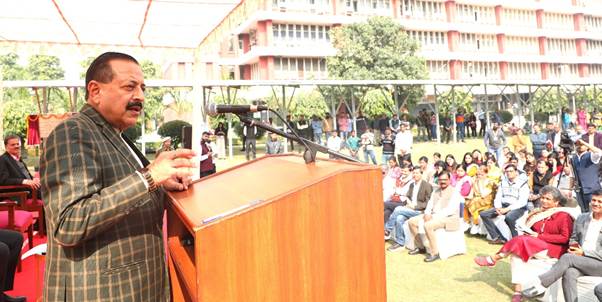Ministry of Earth Sciences
Dr. Jitendra Singh Inaugurates 3 Major Initiatives of India Meteorological Department (IMD), Two New C-Band Doppler Weather Radars, Solar Panel System & Meteorological Museum
Commitment Made to PM Modi being Fulfilled as IMD Nears Triple Radar Capacity, from 47 to 126, by 2027: Dr. Jitendra Singh
Raipur and Mangaluru Get Their First IMD Doppler Weather Radars, Marking Major Boost to Cyclone and Coastal Weather Monitoring
IMD Launches 771 kWp Solar Power System at Mausam Bhawan to Advance India’s Clean Energy Goals
New Radars to Enhance Severe Weather Detection Across Central India, West Coast, and Arabian Sea
Posted On:
27 NOV 2025 5:03PM by PIB Delhi
Union Minister of State (Independent Charge) for Science & Technology; Minister of State for Earth Sciences; MoS PMO, Personnel, Public Grievances, Pensions, Atomic Energy and Space, Dr. Jitendra Singh today inaugurated three major initiatives of the India Meteorological Department (IMD), two state-of-the-art Doppler Weather Radars (DWRs) in Raipur and Mangaluru, a new Solar Power System at Mausam Bhawan, and a Meteorological Museum dedicated to students and young learners.
Addressing the gathering after the launch, the Minister said that under the visionary leadership of Hon’ble Prime Minister Shri Narendra Modi, IMD is rapidly implementing the dream project ‘Mission Mausam’, which the Prime Minister dedicated to the nation during IMD’s 150-year celebrations at Bharat Mandapam on 14 January 2025. He recalled that a pledge was made before the Prime Minister to nearly triple the country’s radar network. “We had committed to expand the radar count from 47 to almost three times by 2027, but I am happy to share that within just a few months, we have already reached 126 radars. We still have two years to go, and I am confident that we will not only meet but comfortably achieve the target well within the timeline,” he said.
Dr. Jitendra Singh emphasised that Doppler Weather Radars are among the most visible and impactful components of weather infrastructure, valued by the public, disaster managers, and policymakers alike. He underlined that weather radars do not recognise administrative boundaries and therefore serve multiple states and regions simultaneously. The radar located in one state, he said, must be understood as a regional asset designed to protect lives and property across its entire coverage span.
A Dual Polarized, Solid-State Power Amplifier-based C-Band Doppler Weather Radar has been installed at Indira Gandhi Krishi Vishwavidyalaya, Raipur—the first such radar in Chhattisgarh. With a 250-km radial coverage, it can detect monsoon depressions, low-pressure systems, heavy rainfall, thunderstorms, lightning, hailstorms, squalls, and turbulence.Its observational reach extends over Chhattisgarh, interior Odisha, eastern Madhya Pradesh, southwest Jharkhand, and southern parts of East Uttar Pradesh, filling a long-standing data gap and significantly improving IMD’s prediction capabilities in these regions.
The second Dual Polarized C-Band Doppler Weather Radar, installed at IMD’s RS/RW Office in Shakthi Nagar, Mangaluru, will provide advanced monitoring of severe weather systems including cyclones, thunderstorms, squalls, heavy rainfall, lightning, hailstorms, and turbulence.With 250 km coverage, the radar will monitor the Arabian Sea adjoining Karnataka, areas of Goa and South Konkan, northern Lakshadweep, and land regions of Karnataka, Kerala, Goa, and South Maharashtra.This is Karnataka’s first IMD radar, and will be crucial for nowcasting and short-range forecasting, strengthening disaster preparedness along the west coast.Both radars have been indigenously developed under the ‘Make in India’ initiative.
The Minister also inaugurated a newly developed Meteorological Museum, designed to inspire students, researchers, and the youth by showcasing IMD’s journey over 150 years.The museum features historic weather instruments, upper-air observational systems, communication tools, radar, and satellite components, and offers audio-visual facilities for interactive learning.
Dr. Jitendra Singh encouraged IMD to conduct structured educational tours for school and college students, calling the museum a “journey down a century of scientific evolution.”
In alignment with India’s clean energy mission, IMD has installed a 771 kWp solar power system across the Mausam Bhawan Complex, comprising 1,315 solar panels installed through NBCC.
Dr. Singh said the initiative supports national goals under the PM Surya Ghar Muft Bijli Yojana, contributes to India’s net-zero commitments, and sets a model for other government buildings.He noted that generated power is expected to exceed IMD’s consumption needs and can be fed back to the grid, enabling both environmental and economic gains.
Speaking on the occasion, Secretary, Ministry of Earth Sciences, Dr. M. Ravichandran said that IMD has now achieved over 50% radar coverage, and is planning additional radars, including urban radars in Delhi, Chennai, Mumbai, and Kolkata, and advanced phased-array radars for the Himalayan states of Jammu & Kashmir, Uttarakhand, and Himachal Pradesh.
Director General, IMD, Dr. Mrutyunjay Mohapatra underlined that IMD’s commitment to enhancing observational, modelling, forecasting, and learning systems, and expressed gratitude for the Minister’s continuous guidance and support.
Dr. Jitendra Singh concluded that today’s launches represent IMD’s contribution to India’s pursuit of Viksit Bharat @2047, combining traditional knowledge with modern technology, expanding disaster preparedness, and advancing the country’s commitment to clean energy. He commended IMD for emerging as a “Vishwa Bandhu” by supporting neighbouring countries through weather services and disaster advisory systems.




*****
NKR/AK
(Release ID: 2195385)
Visitor Counter : 190